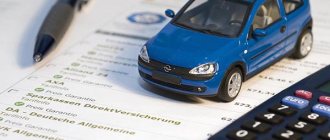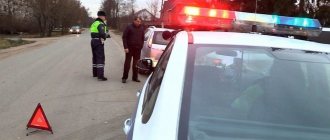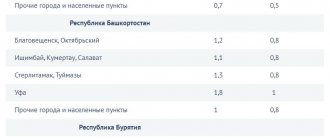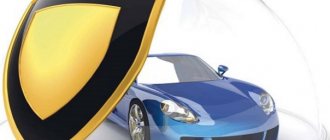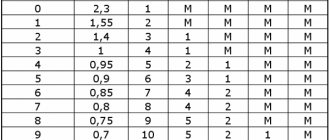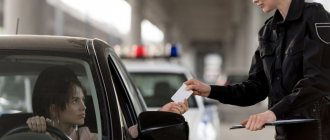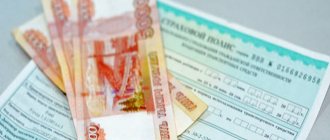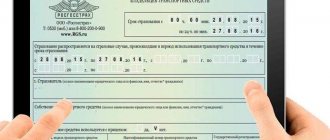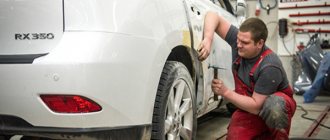Briefly about OSAGO
OSAGO is an agreement on the protection of civil liability, drawn up by two parties: the owner of movable property and the company that ensures its material safety on the road. The main and only circumstance in which it comes into force is a traffic accident that occurred due to the fault of the policy owner. But compensation in case of an accident occurs only in favor of third parties, and not the client himself, as CASCO provides.
Maximum amount of compensation
under compulsory motor liability insurance reaches 160 thousand rubles, provided that more than 2 people were injured in the accident. But if a collision occurred between two cars, then the insurance company is limited to a payment of up to 120 thousand rubles. Therefore, the culprit of a traffic accident sometimes has to pay extra money to the injured party for equipment repairs from his own pocket.
To prevent a citizen from being deceived when assessing the damage received, he needs to find out how the unified calculation of damages under compulsory motor liability insurance is carried out (using the RSA calculator) even before payment. After all, after the transaction has been carried out, it is already useless to compare the amount of funds received with the amount of compensation.
What does the law say about compensation for compulsory motor liability insurance in 2021?
Compared to three to four years earlier, in 2021, insurance payments to cover the costs incurred under compulsory motor liability insurance almost doubled. Law No. 223-FZ of July 21, 2014 “On Mandatory Insurance” states that if a car is damaged as a result of an accident, the insurer can provide no more than 400 thousand rubles, and if damage is caused to life and health, then no more 500 thousand rubles.
Reference! The insurance is paid regardless of how much the insured has had an accident with his participation during the entire period of validity of the MTPL policy.
The numbers are of course decent, but this is the highest limit of the insurance amount that the victim can receive. In practice, it is not always maximum, since many different factors are taken into account. For example, wear and tear on the vehicle, type of damage, estimated value, etc.
To receive insurance compensation, the owner of the insurance policy must notify the insurer of the event no later than 5 days from the moment of the accident. And within 20 days he will file an insurance claim, conduct an examination of the car, make calculations and transfer the insured amount to the previously issued plastic.
What is a unified method for calculating damage
EMRU is a procedure that insurance company representatives can perform on the policy owner’s damaged vehicle in order to accurately calculate the cost of repairing it. This process is based on several formulas derived by the Central Bank. And additional data for applying the mentioned system are about 10 different criteria related to the circumstances of the accident, the mutilated cars and the characteristics of their owners.
Structure
A unified calculation of damage RCA is a document for entering the testimony required to create an estimate for the restoration of movable property. It contains the following points:
- Basic terms of the insurance system and their interpretation;
- General algorithm for calculating the damage received;
- Several formulas;
- A reference book for clarifying some of the data contained in the EMRU form;
- Step-by-step instructions for assessing damaged equipment.
The methodology for calculating the amount of compensation payment itself includes six simple steps:
- Fixation of damaged areas on the machine;
- Studying the circumstances of the accident;
- Drawing up estimates for repairs;
- Accounting for wear of individual spare parts;
- Compiling a list of surviving parts;
- Determining the initial price of the car.
As additions that help establish the exact cost of restoring a vehicle, EMRU suggests using:
- Conclusion from the service station on the work performed (indicating costs);
- Certificate-invoice;
- Video or photographic recording of the damaged vehicle;
- A printout from RSA with current tariff rates for the current year.
A car enthusiast can download a document on a unified methodology for calculating damage under compulsory motor liability insurance for 2019 (with Central Bank formulas) from the official website of RSA, where there is also an electronic database of car brands, consisting of 64 items.
Formula
The simplest and most frequently used formula for calculating losses resulting from an accident looks like this: RK = SR + SM + SD, where:
- RK – amount of compensation payment;
- SR - the amount indicated in the repair estimate;
- SM – price for consumed materials (taking into account their wear);
- CD – the cost of replaced spare parts (damage received before the traffic accident is not restored at the expense of the insurance company).
At the same time, using this payment system, the driver and representatives of the insurance company are required to refer to the same documents. The maximum difference between the average market price of purchased parts and the figures in the estimate should not exceed 10%.
In what cases is it used
Analysis of damage received in a road accident using a unified calculation method is used in almost every insured event. But according to the law of the Russian Federation, only:
- Auto insurers who have the appropriate accreditation to examine damaged vehicles;
- Independent specialists (or organizations providing similar services);
- Private individuals holding a state certificate;
- Representatives of the judiciary.
Attention! Ordinary citizens injured as a result of a road traffic accident have the right only to informally use the calculator to assess harm according to the unified RCA system. Therefore, the data they obtained is prohibited from being presented in court.
Vehicle inspection according to EMRU
The document regulates the procedure for inspecting a vehicle and determining the amount of damage caused to it. Based on the first, an act is drawn up, which indicates defects, including hidden ones, and describes them in detail. To detect damage, the vehicle may be dismantled. Indicate the area of the defect, location, and type of deformation.
Chapter 1 recommends using photographs of the machine taken in accordance with the requirements of Appendix 1 to confirm information about damage. It also indicates the need to first determine ways to eliminate defects.
Chapter 2 describes the procedure for studying the circumstances of an accident. The technician must establish a connection between the incident and the deformation suffered by the machine.
Calculation of repair costs
A car damaged in an accident is a huge financial investment, which sometimes exceeds initial expectations. When calculating repair costs, the following are taken into account:
- All damaged parts of the car body;
- Its spare parts that are out of visual reach;
- Separate mechanical units of the vehicle;
- Paintwork, provided that the general condition of the movable property is not regarded as “totally destroyed”
- Amount of materials used;
- The work itself.
It is important to know! When setting the price, experts take into account the technical characteristics of each element, its current wear and tear resulting from ordinary mileage, and the region where the accident occurred. After all, the cost of auto parts in different regions of the Russian Federation differs significantly.
Regardless of which method is used to assess the damage (online RCA, or during a personal visit to an expert), the date on the conclusion must coincide with the day the accident occurred. Otherwise, such a document will be declared invalid. And if the damaged vehicle already had scratches and dents recorded in the policy, then the insurance company will not take them into account in calculating the amount of compensation for losses.
Rules for drawing up an inspection report for a car damaged in an accident
Before the insurance company begins calculating the amount that will be needed for repairs for the owner of a car injured in an accident, an independent vehicle inspection report must first be drawn up.
It should record the following points:
- On what basis is the vehicle inspected?
- When the inspection began and when was completed.
- Where exactly did the accident occur?
- Complete information about the owner and the person driving the vehicle during the accident (after all, the owner can give his car to a friend or relative for use).
- Complete information about the car. This includes equipment, mileage and the date from which the car began to be used.
- Information about injuries received before the accident. In addition to the damage itself, you also need to describe its type, location, etc. If the car has been repaired or parts have been changed, this is also indicated.
- Data on damage caused by road accidents.
- Current condition of the car.
If the car is moved from the scene of the incident, this action is also reflected in the act. Moreover, not only the fact itself is indicated, but also the address where it was delivered.
Independent examination for RSA
As we have already found out, a unified methodology for calculating damage under compulsory motor liability insurance (RSA), taking into account the prices of spare parts, is required only when an insured event occurs. However, in order to accurately determine the cost of the upcoming repair, the damaged vehicle must be carefully inspected by an independent expert who must meet the following requirements:
- Possession of higher technical education;
- Timely completion of advanced training courses (every 3-5 years);
- Work experience of at least 1 year;
- Availability of a certificate (license) of successful training;
- Relation to the unified electronic register of the union of auto insurers (when contacting the RSA database to calculate damages for a specific risk event, the client can familiarize himself with the personal data of the expert. If his name is not in the register, then, most likely, he has an unoriginal or even counterfeit certificate).
It is important to know! The above conditions are put forward for all independent specialists involved in the inspection of cars, motorcycles, buses and other vehicles damaged in road accidents.
How much is indemnified under compulsory motor liability insurance if there are deaths?
Starting from April 1, 2015, MTPL insurance in Russia began to provide guaranteed funeral payments and financial assistance to families who have lost their breadwinner as a result of an accident.
Reference! Until April 1, 2015, this assistance was paid only to dependents of a deceased person.
Today the amount of compensation is 475 thousand rubles. and an additional 25 thousand rubles. for burial. If several people died in an accident, then compensation is paid to each family of the deceased who was their breadwinner.
Practical calculation example
We learned what criteria are used to calculate damage using the unified RCA method and what is needed to receive compensation without trial. To better understand the harm assessment process, we recommend considering a specific example, broken down into sequential steps:
- A 2012 Cherry Amulet with 75,000 km on it was involved in a traffic accident on April 16, 2017;
- Before calculating the damage received, the expert must assess the level of wear of machine parts using a special formula (in our case, this figure is 35%);
- Next, the vehicle is carefully inspected in order to fix fresh dents, chips and scratches (after an accident, Cherry Amulet suffered damage to the front bumper (3,800 rubles) and the right element of the head optics (3,400 rubles). The total damage is estimated at 7,200 rubles, which, wear and tear of 35%, will decrease to 4680 rubles);
- In addition to replacing damaged spare parts, the car requires mandatory balancing and additional painting, which in total will cost the client 3,100 rubles. This is the sum of the cost of materials consumed;
- Auto mechanics spent 4 hours restoring all affected areas of the vehicle, which at a rate of 1 thousand rubles/60 minutes would be 4 thousand;
- Having all the necessary coefficients in hand, we calculate the total amount of damage received using the single formula RSA - RK = SM + SR + SD (4000 + 3100 + 7200 = 14,300 rubles).
This way, every car owner can calculate the approximate amount of compensation payment for his or her insured event without outside help.
We learned what EMRU is and how to use it at home. In conclusion, it is worth mentioning that the results of such a calculation can only be used to reconcile the report from the insurance company with the actual estimate for restoring the car. The obtained figures cannot be used for other purposes.
What is the structure of EMRU?
Important! EMRU is used only when assessing individuals. Calculations for legal entities are made in a different way.
The unified scheme was developed for the automotive industry, and therefore is used only in this niche. The scheme already covers 67 popular car brands, and this number is regularly increasing .
EMRU is:
- Methodical instructions – 7 chapters.
- Background information presented in the form of 10 annexes.
- An electronic database of prices for auto parts. It contains information about the average prices for paying for work to restore a car. The price is set in standard hours for each region of the country.
The load includes the rules for conducting the technical examination procedure itself.
Regulation No. 433-P describes:
- Nuances of preparing a report.
- Basis for the assessment.
- Objects subject to technical examination.
- Templates for conducting assessments.
The main sections of Regulation No. 432-P are described below.
general information
The first two chapters of the regulation cover general points:
- Chapter 1 describes the goals, objectives of the unified method, and the differences between primary and additional surveys.
- Chapter 2 contains definitions of 29 key terms used in the Regulations.
Expert examination of car damage
The practical part begins to be described in Chapter 3, “The procedure for calculating costs for materials, spare parts and labor.” This section is overloaded with technical information that the expert relies on in his work . Here you can find information about:
- Preparing and conducting an initial inspection of the car after an accident.
- Assessing damage to the coating and the body itself.
- A preliminary forecast about the method of restoring the car.
- Cases when the car cannot be delivered for inspection.
Studying information about road accidents
The purpose of Chapter 4 is to cover all the circumstances of the accident. This is additional control by the traffic police to identify the guilty party and the causes of the accident. This is done through the following types of analysis:
- Expert-comparative – damage on both cars and damaged objects that are indicated in the documentation for the accident are compared.
- Scientific expert. It is carried out by computer modeling.
- Special scientific expert. It is carried out by highly specialized workers. Used in exceptional cases.
Determining the scope of work for vehicle restoration repairs
The most voluminous Chapter 5. This is where algorithms and practical tips for calculating the costs of restoration work are collected. The costs for:
- Parts, components, assemblies.
- Materials for painting, priming, puttying and abrasive work.
- Automotive services. The average hourly wage for each stage of repair is given.
This chapter contains a separate paragraph on determining the wear of the replaced part. So the residual value of the old part is subtracted from the cost of the new part. This difference is minus the sum insured. This is how insurance depreciation is calculated.
The value of the car in its pre-accident condition
The sixth section of the regulation is devoted to methods for calculating the cost of a vehicle before an accident. This is done in order to compare the cost of repairs with the cost of the car before the accident. If it is not practical to make repairs, then the victim receives monetary compensation up to the insurance limit for spare parts.
Information for the calculations performed
Chapter 7 contains references necessary for calculations. Information on each region of the country is collected here. The information provided is based on:
- Regulatory acts of the Central Bank of Russia.
- RSA spare parts price databases.
- Automaker prices.

